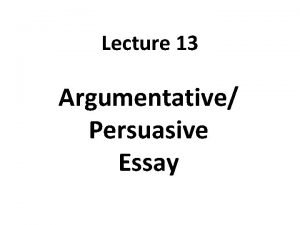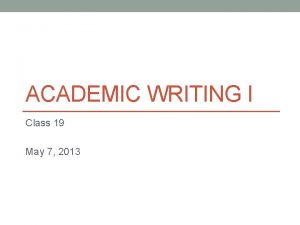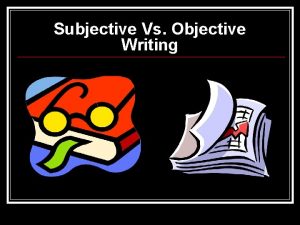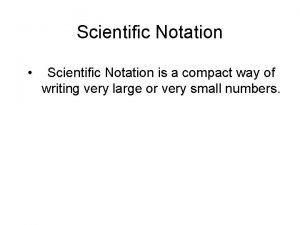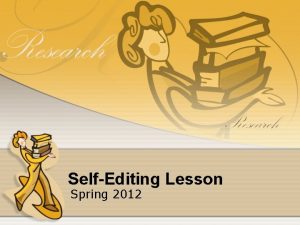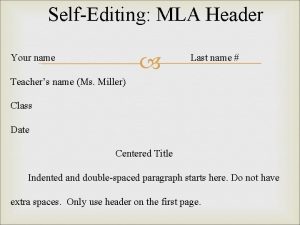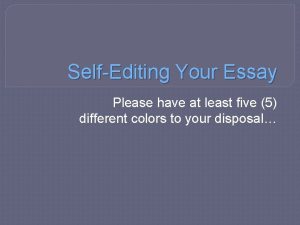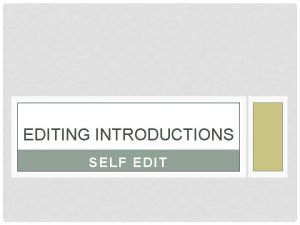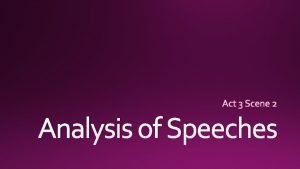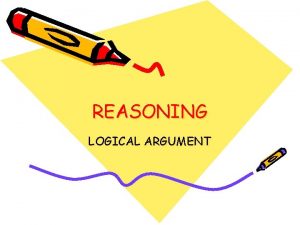Writing an Argument SelfEditing Writing an Argument A












- Slides: 12

Writing an Argument Self-Editing

Writing an Argument • A synthesis argument brings together evidence from more than one source to develop your reasoning and support your assertion/claim.

Writing an Argument Self-Editing - Assertion Read the first sentence of your argument. • Does it provide a clear answer this question? Should students be paid for grades/test scores? • Does it make an assertion? / Answer “What do I think? • Does it include a 1 st person pronoun (I)? • If so, revise the sentence to eliminate the 1 st person pronoun

Writing an Argument Self-Editing - Reasoning Read the second sentence of your argument. • Does it state a reason in support of your assertion/claim? • Does it answer the question “Why do I think that”? • Is the sentence written in your own words instead of taken from one of the two articles? • If not, revise to state the reason in your own words.

Writing an Argument Self-Editing - Evidence Read the remaining sentences of your 1 st paragraph. • Do the remaining sentences provide evidence in support of the reason? • Do they answer the question “How do I know? ” • Is the evidence drawn from at least one of the texts discussed? • Is the evidence drawn from your own experience?

Writing an Argument Self-Editing - Evidence • When including ideas from the articles, do you use attributive phrases to integrate the textual evidence into your argument? • Identify the text the first time you include evidence from the source: • In the article “What Gets Students Motivated to Work Harder? Not Money, ” Matthew Springer claims. . . • In subsequent references use the author’s last name only. • i. e. Kamenetz states. . . / Springer claims. . • Put quotations marks around words or phrases that come directly from a text. / No quotation marks are

Writing an Argument Self-Editing - Reasoning Read the first sentence of your second paragraph. • Does it state a different reason in support of your assertion/claim? • Does it answer the question “Why do I think that”? • Is the sentence written in your own words instead of taken from one of the two articles? • If not, revise to state the reason in your own words.

Writing an Argument Self-Editing - Evidence Read the remaining sentences of your 2 nd paragraph. • Do the remaining sentences provide evidence in support of the stated reason? • Do they answer the question “How do I know? ” • Is the evidence drawn from at least one of the texts discussed? • Is the evidence drawn from your own experience?

Writing an Argument Self-Editing - Evidence • When including ideas from the articles, do you use attributive phrases to integrate the textual evidence into your argument? • Identify the text the first time you include evidence from the source: • In the article “”Paying Students May Raise Test Scores, ” Anya Kamenetz claims. . . • In subsequent references use the author’s last name only. • i. e. Kamenetz states. . . / Springer claims. . • Put quotations marks around words or phrases that come directly from a text. / No quotation marks are

Writing an Argument Self-Editing - Conclusion Read the last sentence of the second paragraph. • Does it provide a summarizing statement of your assertion and reasons? • Proofreading • Check capitalization, punctuation, grammar, spelling, and complete sentences. • Revision – revise the draft of your argument

Writing an Argument Peer Review After revising your argument, swap drafts with a partner. Read your partner’s argument and provide feedback and suggestions.

Writing an Argument Revision Revise your argument, keeping your partner’s comments in mind. Submit to the Haiku dropbox labeled REVISION
 Teleological argument vs ontological argument
Teleological argument vs ontological argument Writing an argument portfolio
Writing an argument portfolio Narrative quiz
Narrative quiz Persuasive vs argumentative
Persuasive vs argumentative Informal tone
Informal tone Informal writing types
Informal writing types Differentiate academic writing with technical writing.
Differentiate academic writing with technical writing. Argumentative essay vs persuasive
Argumentative essay vs persuasive Business writing vs academic writing
Business writing vs academic writing Literature and journalism similarities
Literature and journalism similarities Passive voice ppt
Passive voice ppt Subjective vs objective writing
Subjective vs objective writing 7x10x10x10
7x10x10x10



